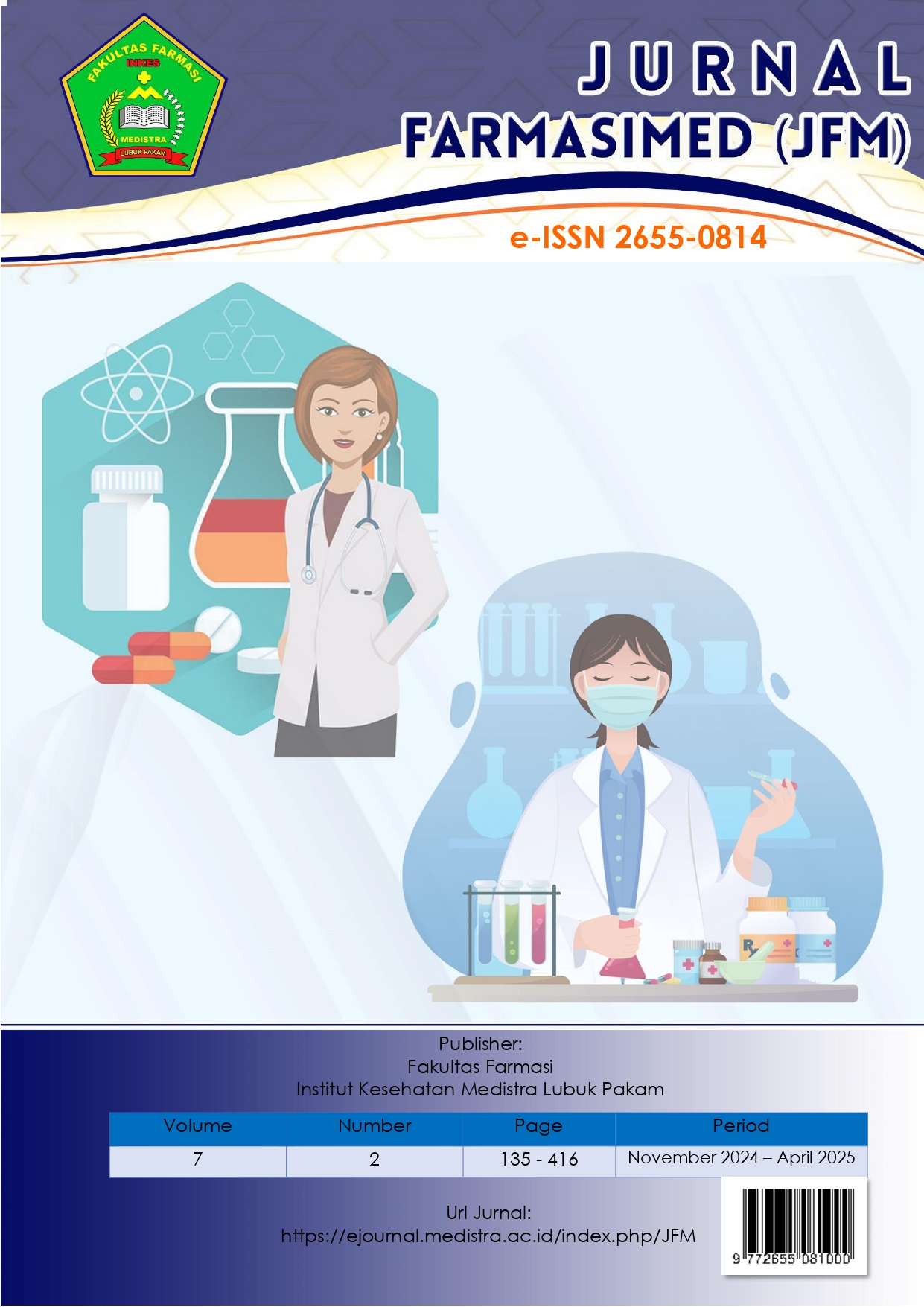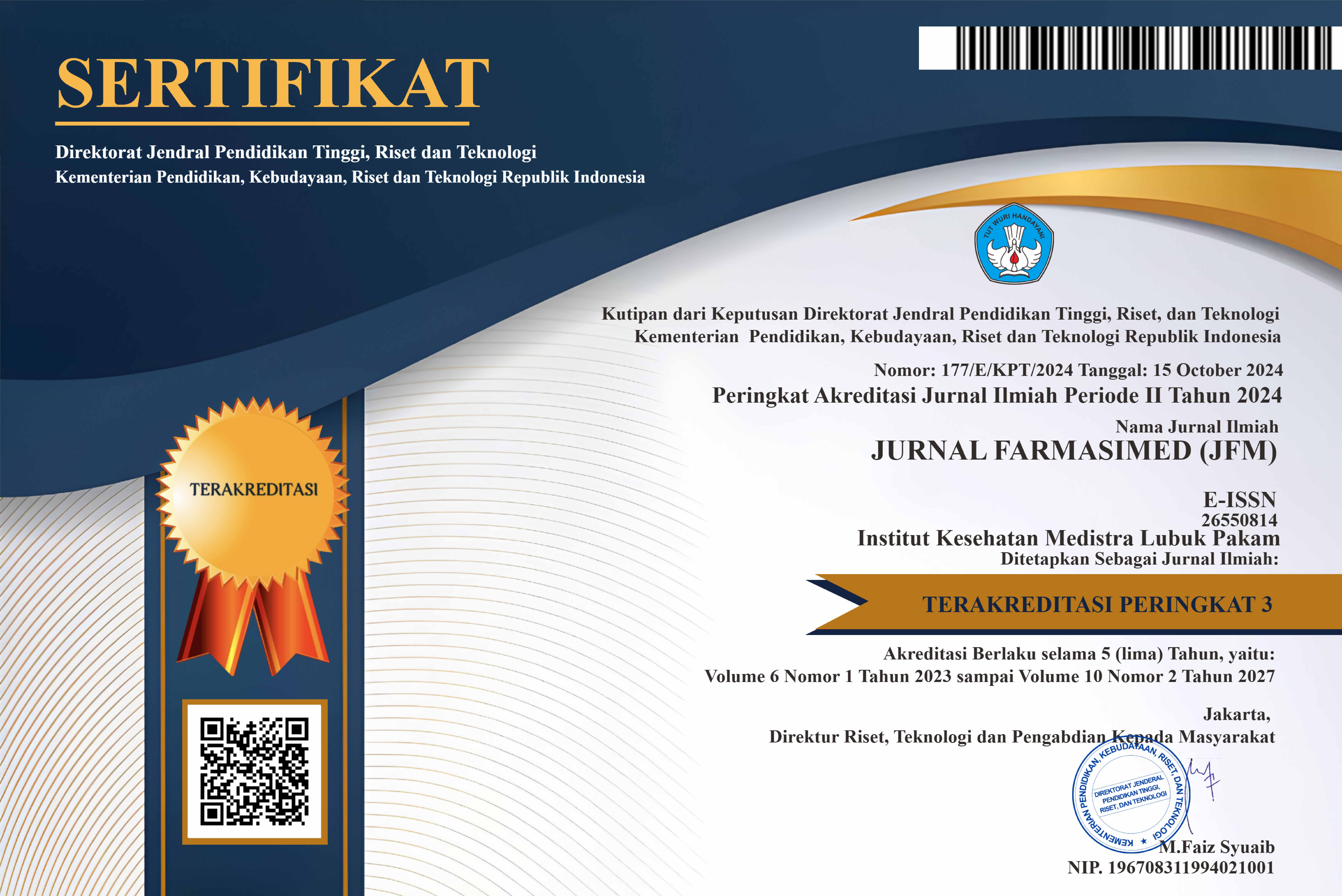Test Of Antibacterial Activity and GC-MS analysis of ethyl acetate and N-hexane fractions of Kenitu leaves (Chrysophyllum cainito L.)
DOI:
https://doi.org/10.35451/jfm.v7i2.2421Keywords:
Fractionation, Kenitu leaves, Secondary Metabolites, AntibacterialAbstract
Background: As a result of the large number of infectious diseases, every year 3.5 million people die. The more microorganisms that are resistant to antibiotics, the search for and research into new antibacterials must be carried out from medicinal plant extracts such as the kenitu leaf plant, whose antibacterial activity is still rarely researched. Objectives: to analyze the factors that influence the management of solid media waste of hazardous and toxic materials at RSUD.Kumpulan Pane, Tebing Tinggi City. Research method: This research is a type of laboratory experiment using the semi-polar solvent ethyl acetate and the non-polar solvent n hexane from kenitu (Chrysophyllum cainito L.) leaves to test their antibacterial activity using the disk diffusion method. In this study there were six treatment groups: positive control (+) ciprofloxacin, negative control (-) DMSO 10%, as well as four concentration variations, namely K1: 25 mg/ml, K2: 50 mg/ml, K3: 100 mg/ml, and K4: 500 mg/ml. Results: The results of the ANOVA test of the antibacterial activity test of the Bacillus subtilis fraction against the ethyl acetate fraction obtained a p value <0.001. From the results of the homogeneity test, a significant value of p = 0.023 was obtained. These values ??are in accordance with the criteria (p <0.05), meaning that the concentration treatment has a significant impact on the diameter of the inhibition zone. Based on the results of the two tests, the data obtained in this study were analyzed using the non-parametric Kruskal-Wallis statistical test showing that there was a difference in the average Asymp value in each treatment. Sig. = 0.005 (p <0.05). The results of the Mann-Whitney test of the ethyl acetate fraction on Bacillus subtilis bacteria stated that it had a significant difference in providing an inhibition zone. Conclusion: the analysis stated that there were 27 compounds that were identified in the ethyl acetate fraction and 19 compounds that were identified in the n-hexane fraction of kenitu leaves. The results of testing regarding antibacterial activity stated that the kenitu leaf fraction from ethyl acetate solvent was only able to inhibit the growth of Bacillus subtilis and Staphylococcus aureus bacteria at a concentration of 500 mg/ml, for the kenitu leaf fraction from n-hexane solvent stated that all concentrations were not possible. able to inhibit the growth of Staphylococcus aureus, Pseudomonas aeruginosa, Escherichia coli and Bacillus subtilis.
Downloads
References
Purnama SG, Purnama H, Subrata IM. Kualitas Mikrobiologis Dan Higiene Pedagang Lawar Di Kawasan Pariwisata Kabupaten Gianyar. J Kesehat Lingkung Indones. 2017;16(2):56.
Nurjanah U. Efektivitas Perasan Daun Bahagia (Dieffenbachia bowmanii) Terhadap Pertumbuhan Bakteri Staphylococcus aureus. UMSurabaya Repos [Internet]. 2018;53(5):1–116. Tersedia pada: http://repository.um-surabaya.ac.id/id/eprint/3328
Eryatma RA, Suriaman E, Rahayu DP, Fadhila Ul. Uji Kualitatif Senyawa Fitokimia Chrysophyllum cainito L. Dan Pengaruhnya Sebagai Senyawa Antibakteri Pada Escherichia coli dan Staphylococcus aureus. Aiptlmi. 2022;229–38.
Il- EB V, Th M. Utaminingtyas, Nur Imamah. Uji aktivitas ekstrak etanol 70% daun kenitu (Chrysophyllum cainito) terhadap peningkatan kepadatan tulang traberkular vertebra mencit betina yang diinduksi deksametason. Diss. Universitas Islam Negeri Maulana Malik Ibrahim, 201. 2017;2–4.
Dinaran A, Saleh C, Pratiwi DR. Aktivitas Antibakteri Ekstrak Metanol Daun Kenitu (Chrysophyllum cainito L.) Terhadap Salmonella thypi ATCC 422. Semin Nas Kim dan Terap II 2022. 2022;1–5.
Zahro F. Uji Aktivitas Inhibitor a-Glukosidase Ekstrak Etanol 70% Daun Kenitu (Chrysophyllum cainit L). Repos Univ Jember. 2015;3(3):69–70.
Aureus S. Progam Studi S1 Fakultas Farmasi Universitas Muhammadiyah A . R Fachruddin Tangerang. 2022;
Pakpahan dan Sutriningsih. Uji Aktivitas Antibakteri Fraksi N-Heksan, Etil Asetat, Dan Butanol Daun Petai Cina ( Leucaena leucocephala ( Lam .) de Wit ) Terhadap Bakteri Propionibacterium acnes Dan Staphylococcus epidermidis Secara In Vitro Fraction Of Lead Tree ( Leucaena leucocep. Indones Nat Res Pharm J. 2020;5(2):12–9.
Aprilliani A. Uji inhibisi aktivitas enzim tirosinase beberapa jenis tumbuhan anggota suku Zingiberaceae. J Ilm Farm. 2018;14(1):46–57.
Pupunk Fajriyani, Aulia Nur Rahmawati, Novena Yety Lindawati. Aktivitas Antibakteri Fraksi Etil Asetat Daun Jambu Air (Syzygium aqueum) Terhadap Shigella dysentriae. J Ilm Manuntung. 2022;8(2):266–76.
Mahmiah, Sudjarwo GW, Andriyani F. Skrining Fitokimia dan Analisis GC-MS Hasil Fraksi Heksana Kulit Batang Rhizophora Mucronata L. Semin Nas Kelaut XII. 2017;(2016):44–51.
Revathi P, Jeyaseelansenthinath T, Thirumalaikolundhusubramaian P. Preliminary phytochemical screening and gc-ms analysis of ethanolic extract of mangrove plant-bruguiera cylindrica (rhizho) l. Int J Pharmacogn Phytochem Res. 2014;6(4):729–40.
Pratama Y. Studi aktivitas antibakteri dari nanoemulsi fraksi ekstrak batang pucuk idat (Cratoxylum Glaucum). 2020;3(April):49–58.
Syamsul ES, Amanda NA, Lestari D. Perbandingan Ekstrak Lamur Aquilaria malaccensis Dengan Metode Maserasi Dan Refluks. J Ris Kefarmasian Indones. 2020;2(2):97–104.
Utomo SB, Fujiyanti M, Lestari WP, Mulyani S. Antibacterial Activity Test of the C-4-methoxyphenylcalix[4]resorcinarene Compound Modified by Hexadecyltrimethylammonium-Bromide against Staphylococcus aureus and Escherichia coli Bacteria. JKPK (Jurnal Kim dan Pendidik Kim. 2018;3(3):201.
Yusmaniar., Wardiyah., Khairun N. 2017. Mikrobiologi dan Parasitologi. Kementerian Kesehatan Republik Indonesia. Jakarta.
Lestari Y, Ardiningsih P, Nurlina. Aktivitas Antibakteri Gram Positif Dan Negatif Dari Ekstrak Dan Fraksi Daun Nipah (Nypa Fruticans Wurmb.) Asal Pesisir Sungai Kakap Kalimantan Barat. J Kim Khatulistiwa. 2016;5(4):1–8.
Rosmania, Yanti F. Jurnal Penelitian Sains. J Penelit Sains [Internet]. 2020;21(3):163–7. Tersedia pada: http://ejurnal.mipa.unsri.ac.id/index.php/jps/index
Faidiban AN, Posangi J, Wowor PM, Bara RA. Uji Efek Antibakteri Chromodoris annae terhadap Bakteri Staphylococcus aureus dan Escherichia coli. Med Scope J. 2020;1(2):67–70.
Oktaviani DJ, Widiyastuti S, Maharani DA, Amalia AN, Ishak AM, Zuhrotun A. Review: Bahan Alami Penyembuh Luka. Farmasetika.com (Online). 2019;4(3):44.
Nangoi R, Paputungan R, B.Ogie T, Kawulusan RI, Mamarimbing R, Paat FJ. Uji Aktivitas Antibakteri Buah Kecombrang (Etlingera elatior) Yang Diekstrak Dengan Menggunakan Beberapa Pelarut. Juranal Agroekoteknologi Terap. 2022;3:422–8.
Sari DP, Pangemanan DHC, . J. Uji daya hambat ekstrak alga coklat (Padina australis Hauck) terhadap pertumbuhan bakteri Porphyromonas gingivalis secara in vitro. e-GIGI. 2016;4(2).
Sumitriasih NL, Ridhay A, Indriani. Uji Aktivitas Antibakteri Ekstrak n-Heksan, Etil Asetat Dan Etanol Kulit Batang Kayu Eboni (Diospyros celebica Bakh.) Menggunakan Metode Difusi. Kovalen J Ris Kim. 2019;5(3):233–9.
Holiffah, N., Permana, D.A. and Swandari, M.T.K., 2022. Uji Aktivitas Antioksidan Ekstrak Daun Kenitu (Chrysophyllum Cainito L.) Secara In Vitro Dan In Vivo Dalam Sediaan Krim Tabir Surya. Prosing Artikel, 67.
Downloads
Published
Issue
Section
License
Copyright (c) 2025 Sefi Megawati, Meta Safitri, Saru Noliqo Rangkuti, Luthfiyyatul Makiyyah, Nur Indah Arum Mawarni

This work is licensed under a Creative Commons Attribution-NoDerivatives 4.0 International License.
Copyright in each article is the property of the Author.

























